
Photograph source:「History of Concrete Dams in Hokkaido」(Association for Civil Engineering Technology of Hokkaido Concrete Research Committee)
| Structure name | Kanayama DAM |
|---|---|
| Structure type | Hollow gravity concrete dam |
| Purpose | Flood control、Water sypply for Agriculture、Water supply for city water、Hydropower |
| Structural factors | Height57.3m、Crest length288.5m、Volume220×10³m³、Ponding area920ha、Total reservoir capacity150,450×10³m³ |
| Operator | Hokkaido Regional Development Bureau Development and Construction |
| Designer | Hokkaido Regional Development Bureau Development and Construction |
| Contractor | Kajima Co. |
| Location | Minamihurano town |
| River system | Ishikari River/Sorachi River |
| Completion date | 1967 |
| Overview | Kanayama Dam is the only hollow gravity concrete dam in Hokkaido, with a bank height of 57.3 meters and a top bank length of 288.5 meters. This type of dam is similar to a gravity concrete dam, but is hollow inside to reduce the amount of concrete used. This results in a more complicated structure, and the formwork area becomes very large, so it was a useful approach during the period when cement was expensive and the labor cost was low. However, the shear stress generated in the ground around the foundation is larger than that of a standard gravity dam of equal height. In 1959, the “Comprehensive River Development Project Survey” was approved, and an initial investigation began in 1960 at the dam site to implement a “specific multipurpose dam method” for the first time in Hokkaido. Since the foundation rock was composed of relatively good schalstein, which can retain sufficient strength even under concentrated loads, a hollow gravity shape was chosen, which could reduce the amount of concrete by 23% relative to the typical gravity type. At the time of construction, cement was expensive and labor inexpensive, so it was economic to reduce the amount of concrete even if the formwork area was large, and this allowed for a shortened construction period and reduced construction cost. Blast furnace cement with a substitution rate of 55% was used. The degree of fineness of the blast furnace slag powder was changed to 3000 plus/minus 200 square centimeters per gram, and the sulfuric anhydride SO3 was changed to 2.5 plus/minus 0.2% to control long-term strength gain and reduce initial heat of hydration. Since then, this type of dam-specific blast furnace cement was used in many dam projects. |

